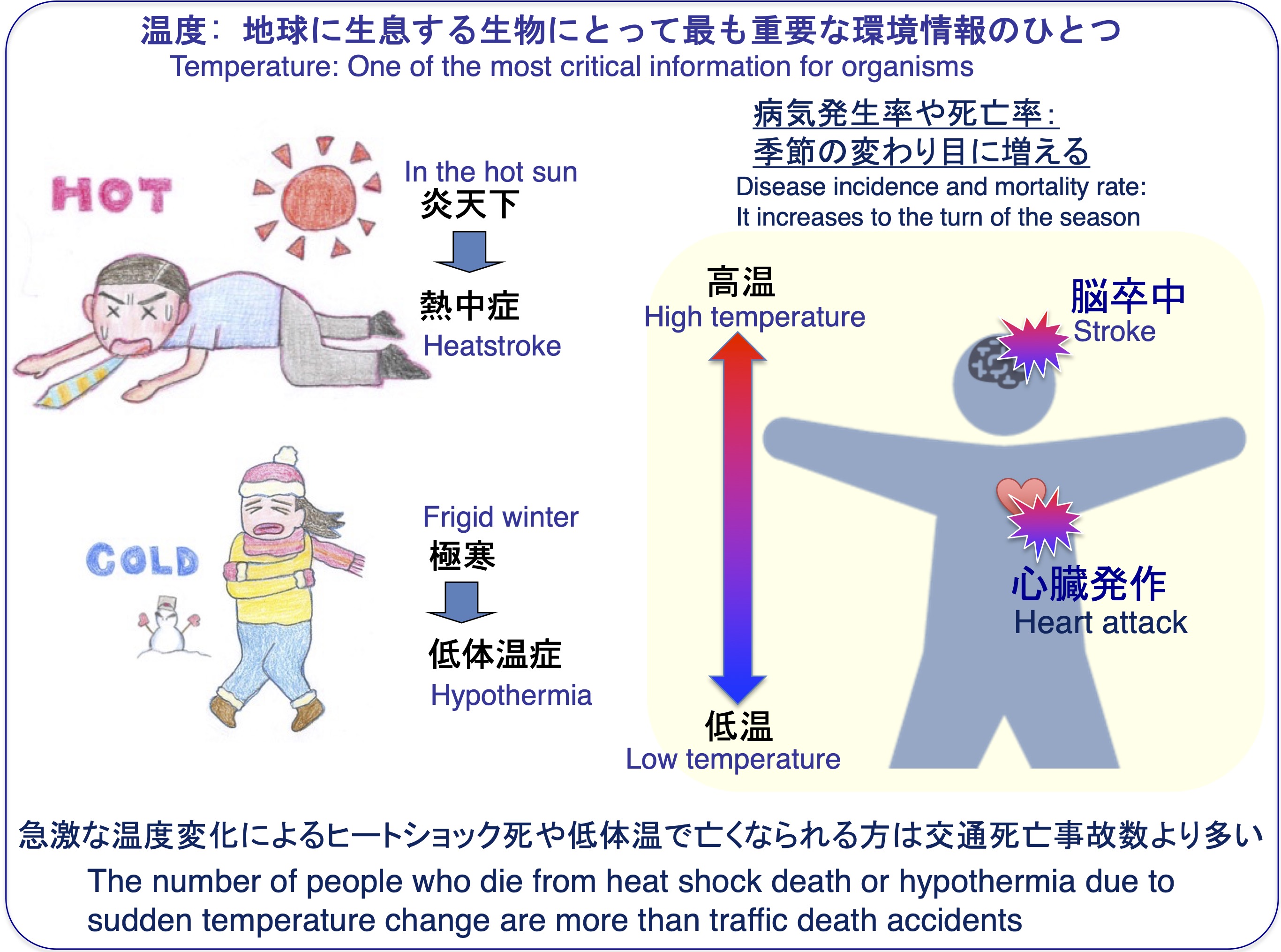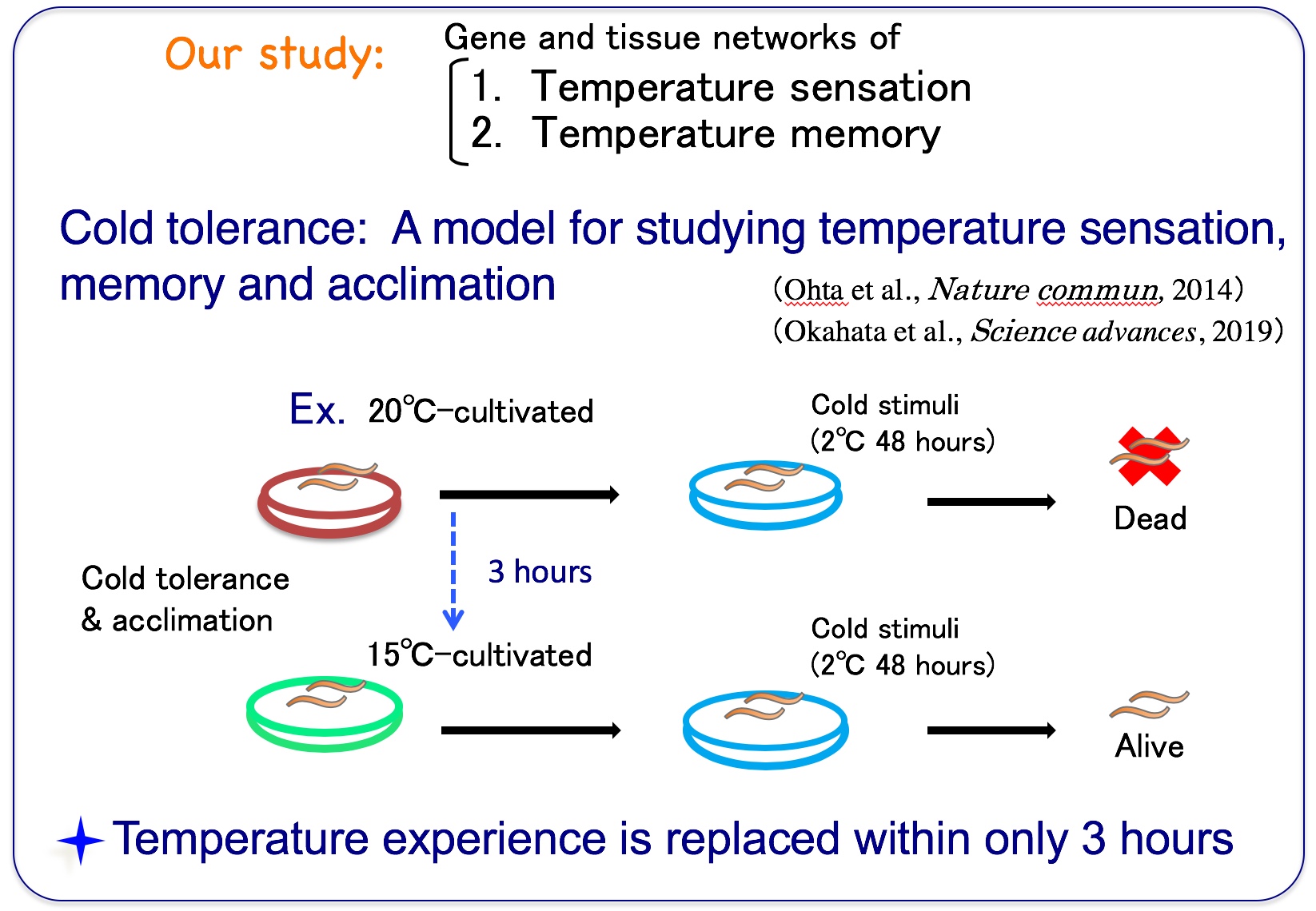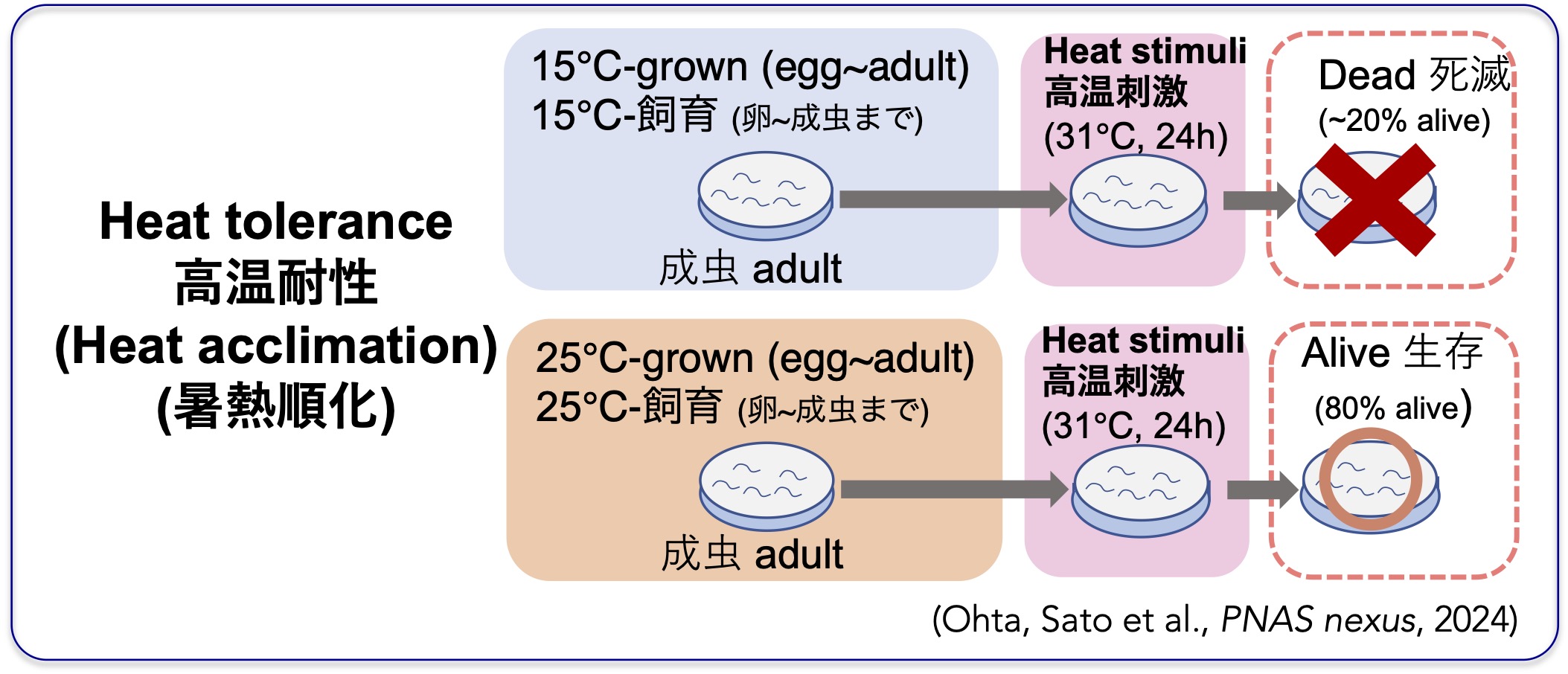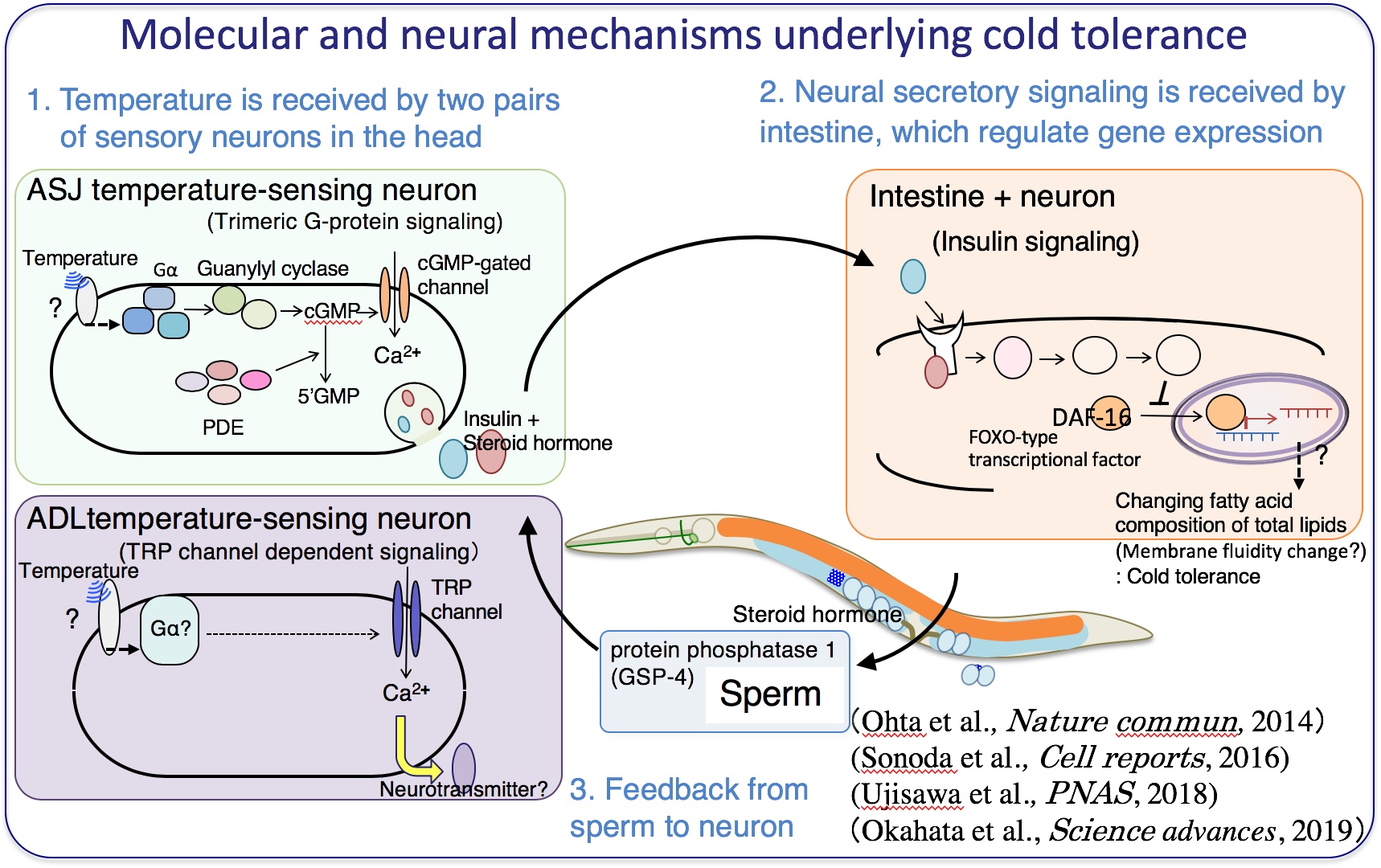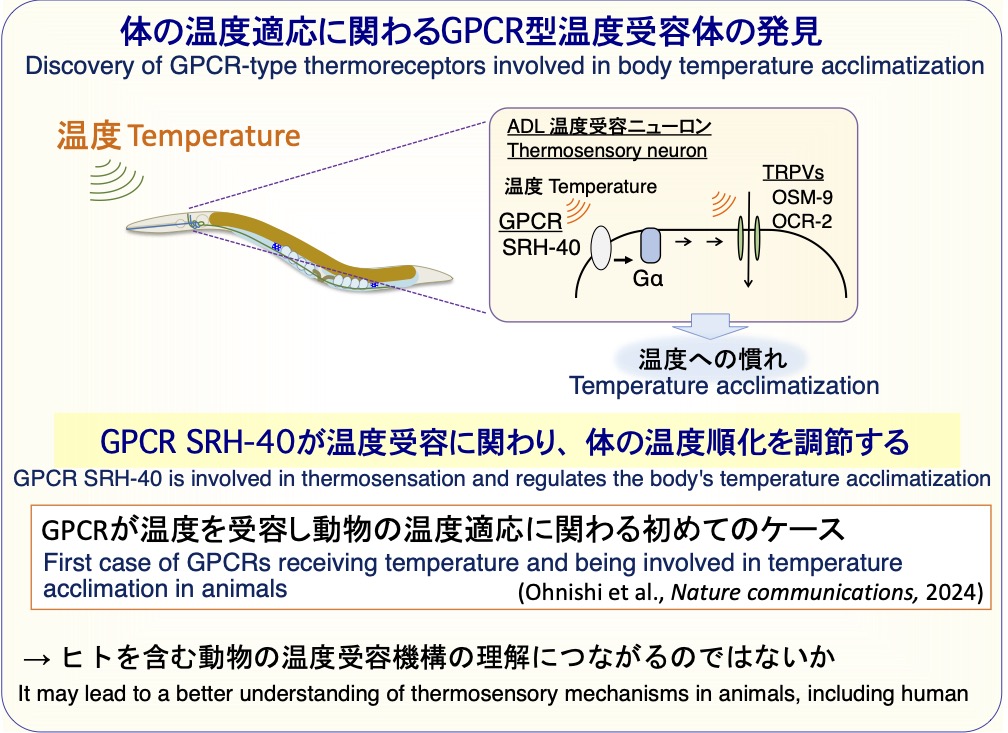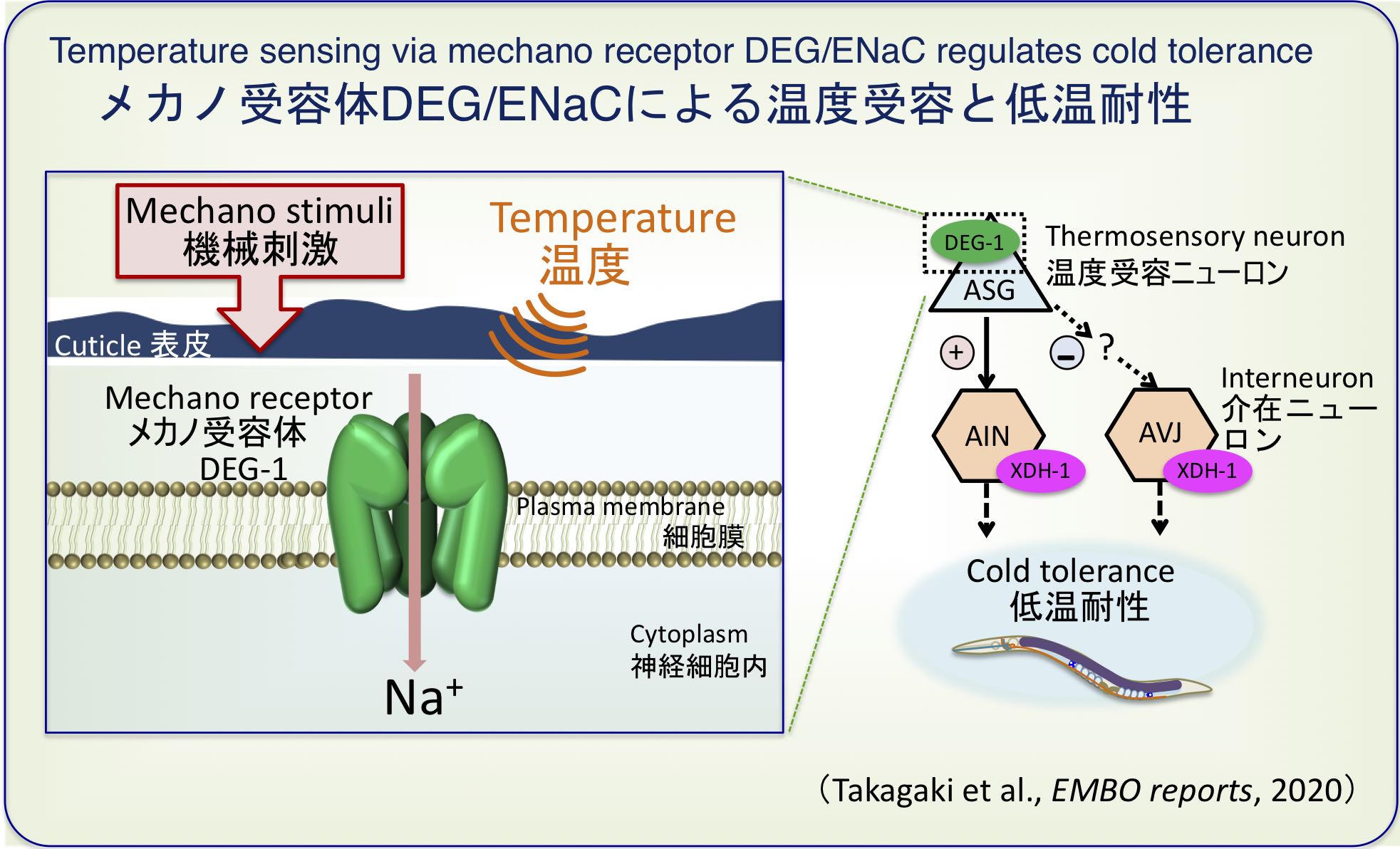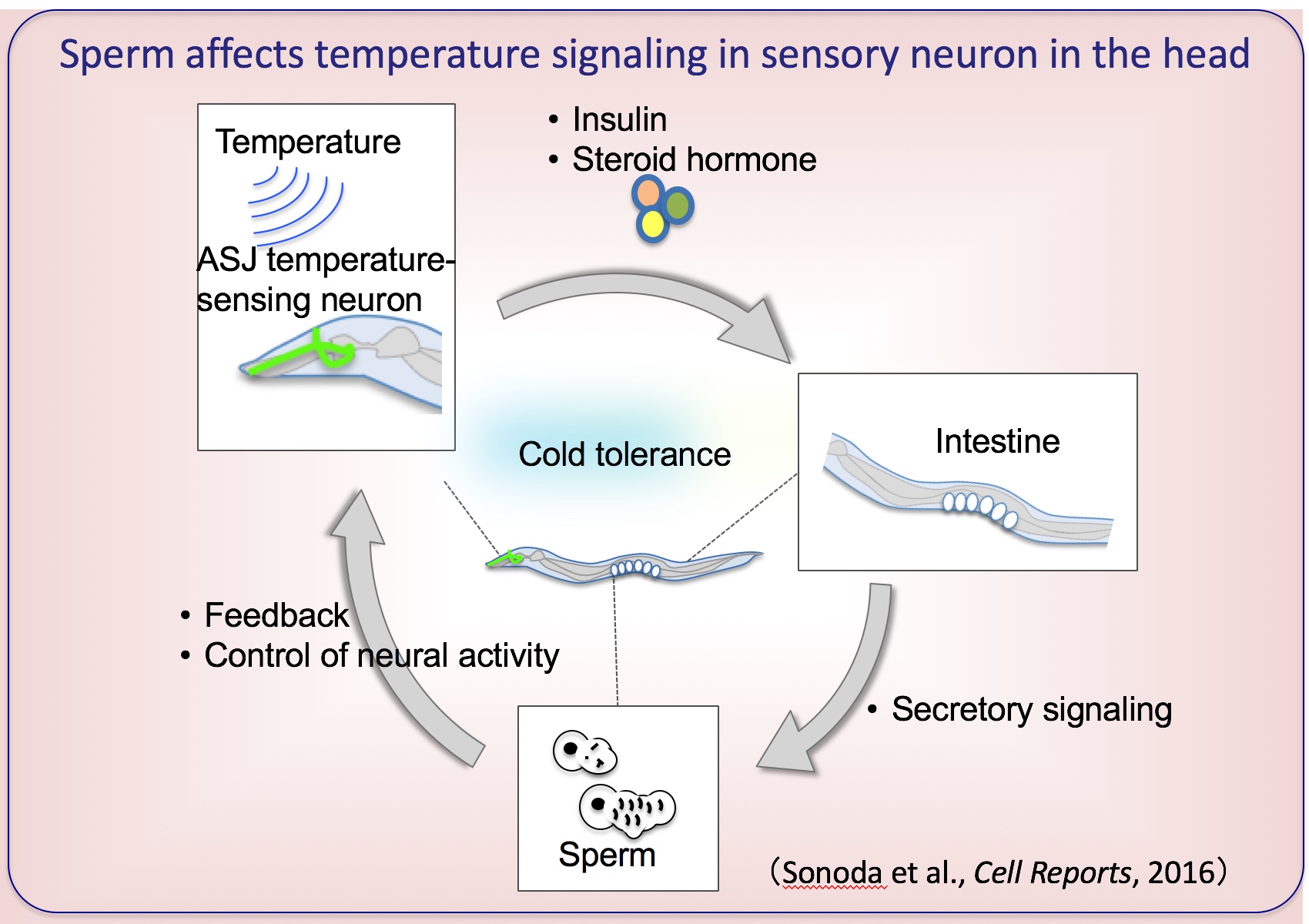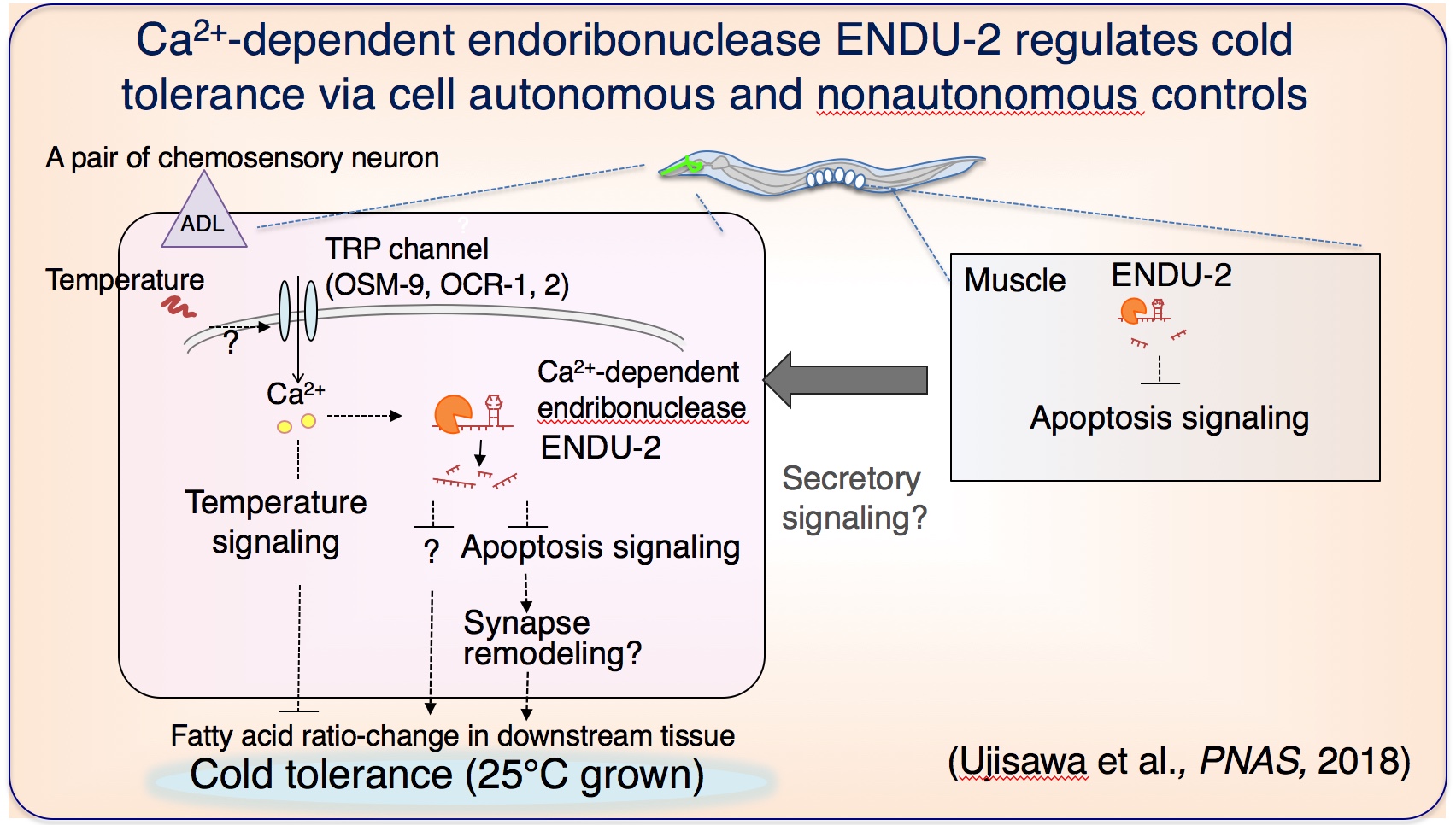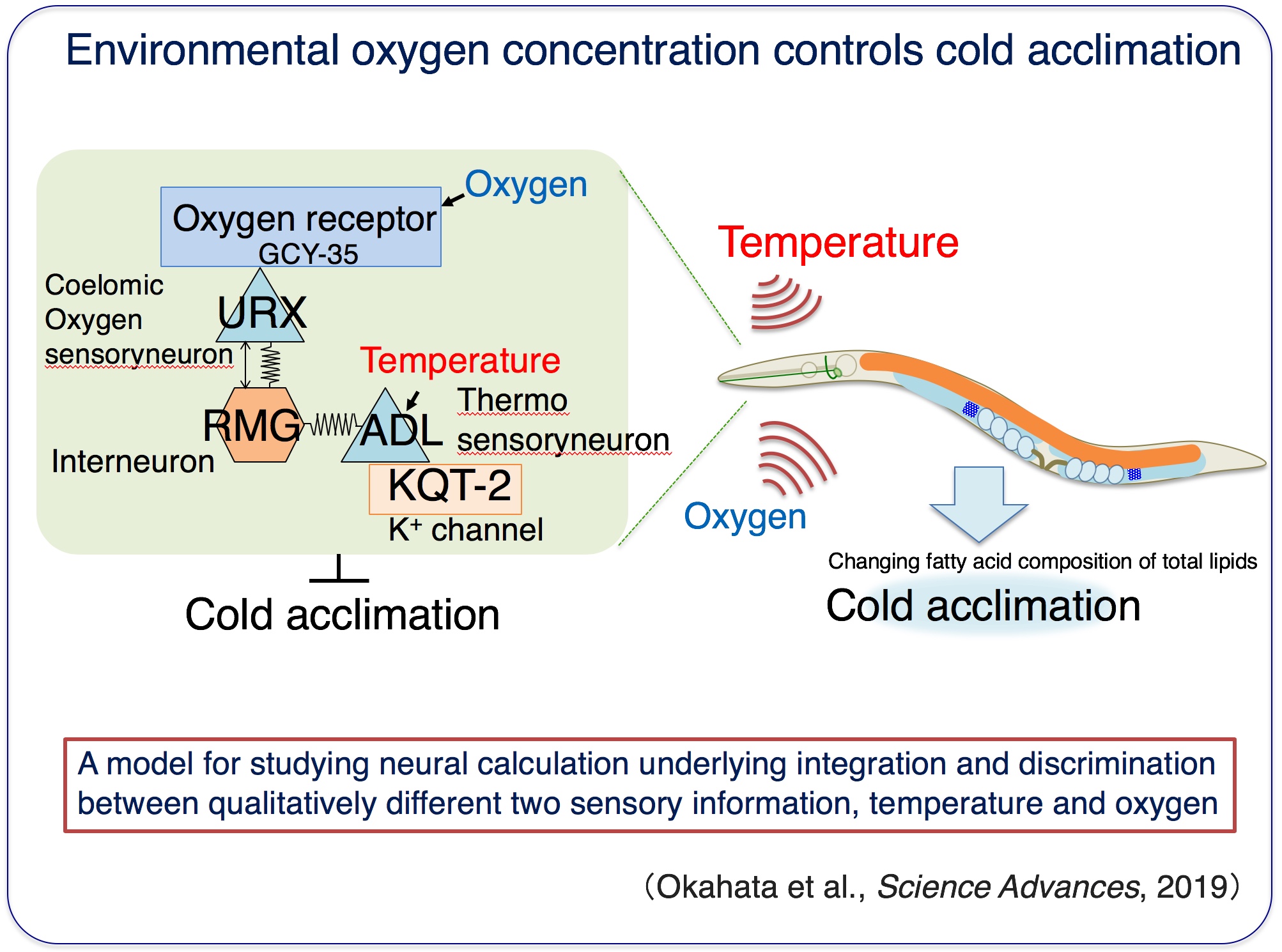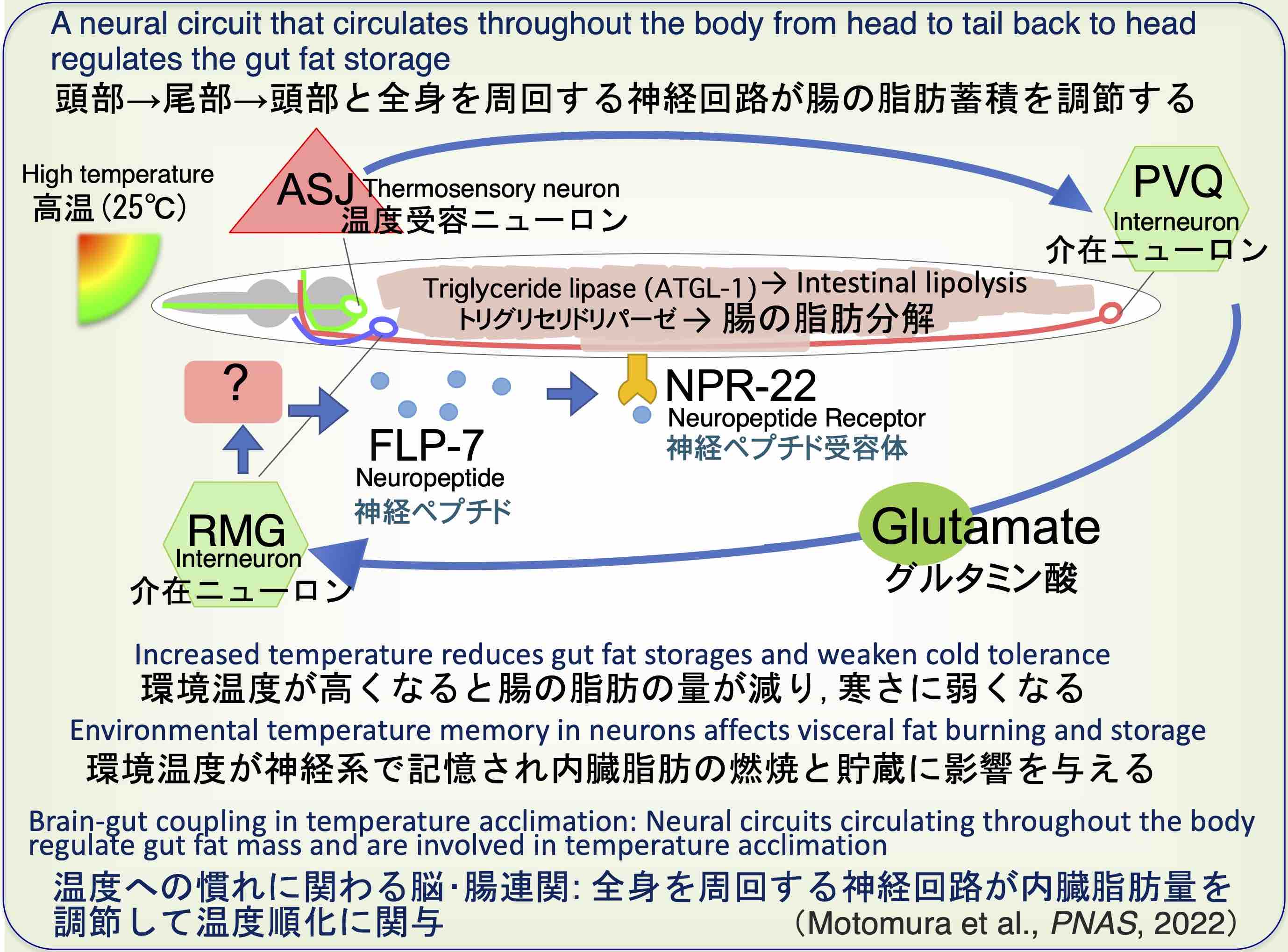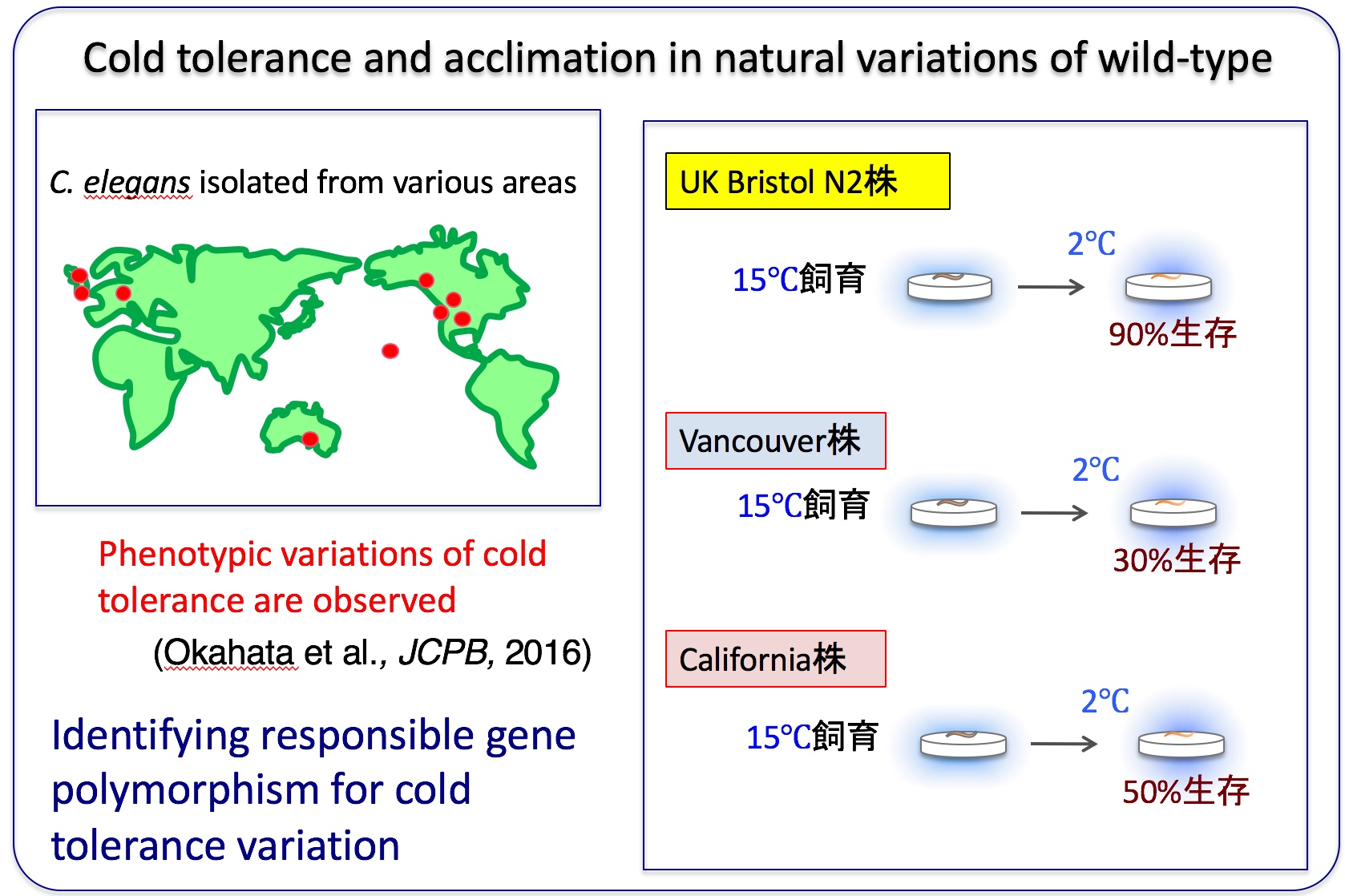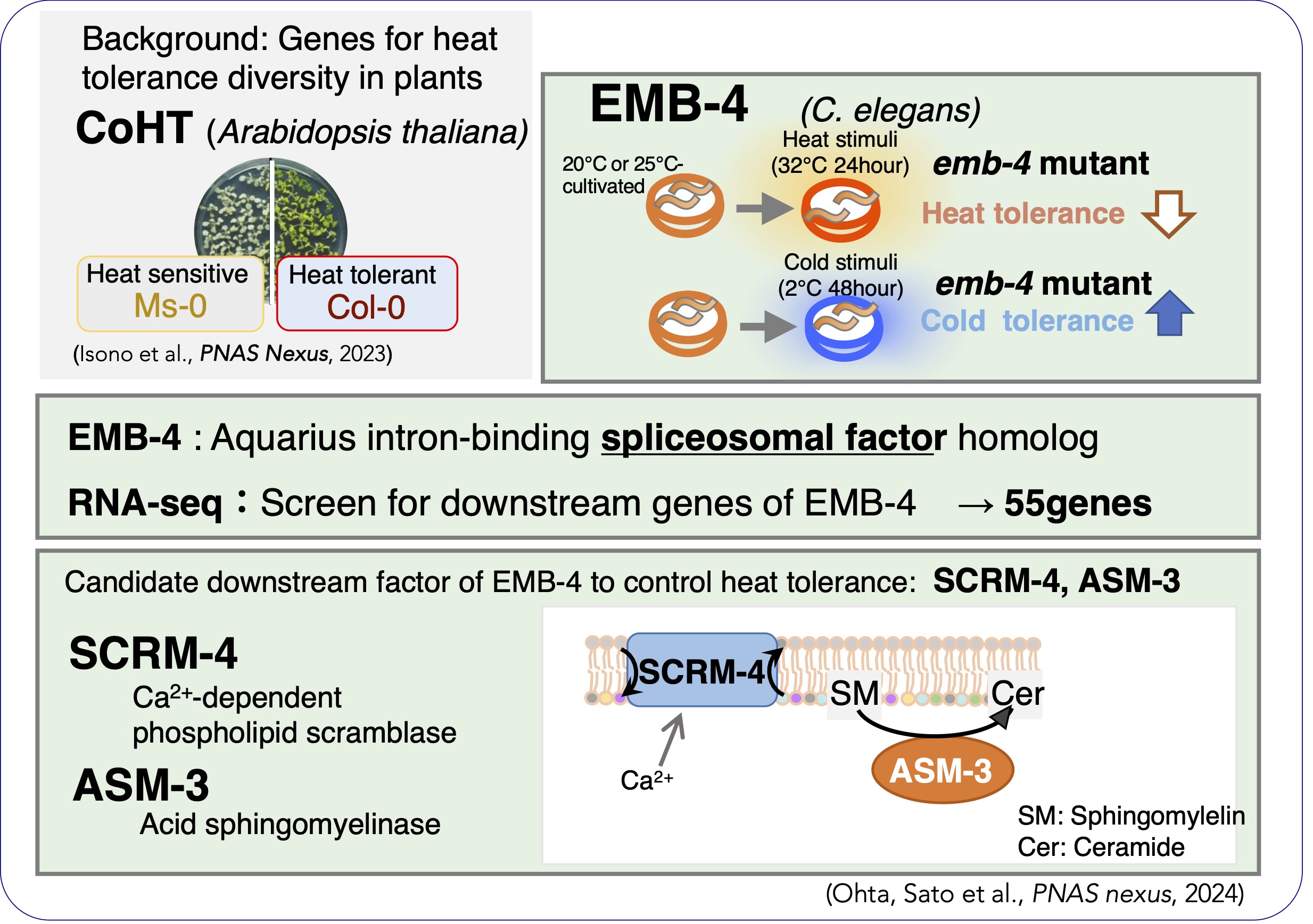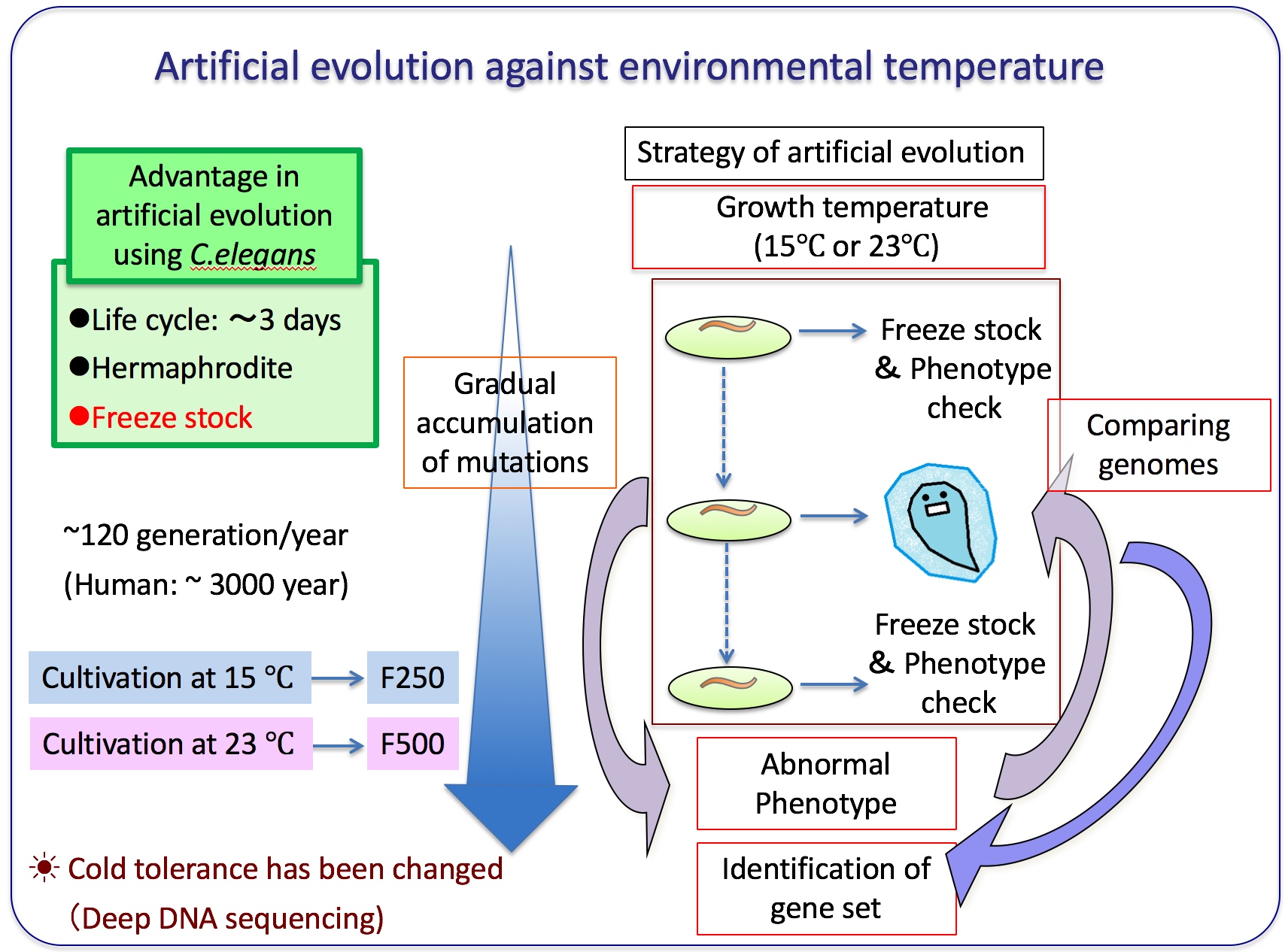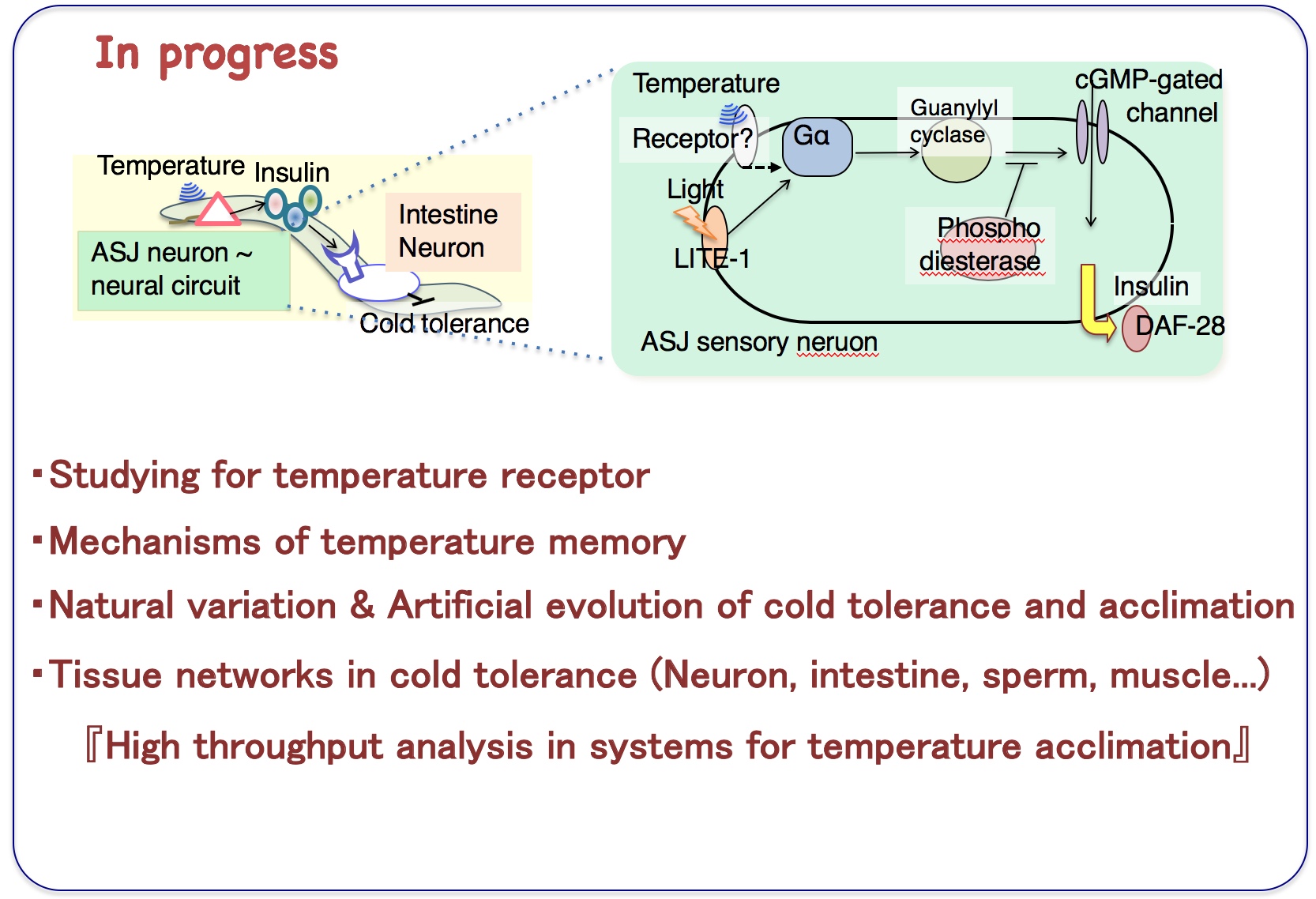Atsushi KUHARA Laboratory
Our Research Activities and Accomplishments So Far

Elucidation of temperature response and memory in animal
Our environment contains many sensory information, such as light, smell, oxygen and temperature. In these information, temperature is one of the most essential environmental information, because temperature is always present on the earth and directly affect biochemical reaction of organisms. Then, appropriate responses and habituation for temperature changes are important for living and proliferation of organisms including human.
Kuhara’ laboratory is using cold tolerance and acclimation of nematode Caenorhabditis elegans as a model for studying (1) how animals sense and memorize temperature, (2) how to tolerate and acclimate against temperature changes, and (3) how to adapt and evolve to environmental temperature.
Since many fundamental biological mechanisms are conserved through C. elegans to human, our study will lead to elucidate important biological systems (1) how sensation and memory are regulated in animals including human, (2) tissue mechanism for temperature acclimation, and (3) how animals have been adapt to and evolve to environment.
On practical aspect, our cold tolerance of C. elegans has been utilized for large scale screening for new drugs effective against temperature dependent biological events in human, in collaboration with pharmaceutical company. Besides, we have been developed optical systems for analyzing neural activity, in collaboration with a company.
Background on studying for cold and heat tolerance
Temperature is a crucial environmental factor for the survival of organisms. For example, in humans, a drop in body temperature of just 36°C to 33°C can lead to a state of suspended animation. Additionally, disease incidence and mortality rates increase during periods of significant temperature fluctuations.
Temperature-related illnesses are numerous, and deaths from heat shock and hypothermia caused by sudden temperature changes have become a significant social issue, reportedly resulting in more fatalities than traffic accidents.
On a global scale, it is reported that 30% of species are threatened with extinction due to global warming and localized cold spells, making adaptation to temperature a critical global challenge.
Mechanisms for cold tolerance and acclimation have been studying in various organisms such as human, insect and plant. A common mechanism throughout plant to insect is known that increment of the unsaturated fatty acid content in a membrane increases cell-membrane fluidity, resulting in preventing from freezing cell.
For the past half-century, it is known that storage of low-molecular-weight sugar-alcohol such as glycerol and sorbitol, as well as sugar such as trehalose and glucose, prevent tissues from freezing under cold condition.
Although metabolic biotransformation for inducing a cold tolerance is reported, there are many unidentified points in a molecular signaling from temperature input as a sensation to cold tolerance as an output.
To reveal these molecular biological regulations for responding temperature, we are using simple model animal, nematode C. elegans.
Experimental model of animal temperature response and memory using temperature tolerance and temperature acclimation of C. elegans
Global warming and regional climate cooling are critical issues on the survival of life. Here in Kuhara Lab, we investigate to elucidate the mechanism in molecule and tissues regarding temperature sensing and memorizing in relation with temperature tolerance and acclimation systems of animals.
In the process of the study of temperature seeking behavior, thermotaxis, we fortunately noticed C. elegans' cold tolerance and cold acclimation. We raised a wild-type strain of C. elegans (UK, DR) in the chamber with a temperature of 20℃; when we moved the particular strain to the chamber of 2℃, it was exterminated (20℃ > 2℃: terminated). We then raised another one in the temperature of 15℃ and moved it to the 2℃ chamber, and over 90 % of the particular strain has survived (15℃ > 2℃: 90% survived); the result suggests that the C. elegans has acclimated itself to the colder environment (developing acclimation and tolerance to temperature change), internally controlling itself.
Moreover, the 20℃ chamber strain has also gained the same tolerance by putting it in the 15℃ chamber for only three hours (Ohta, Ujisawa et al., Nature commun., 2014). Since the phenomenon is controlled in the nervous system by the gene responsible for the memory of mammals, it can be used as the memory analysis model system.
We are investigating the cold tolerance phenomenon to analyze the molecular mechanism that controls thermosensation and memory.
Heat tolerance and heat acclimation have also been discovered. We investigated whether the wild-type strain of C. elegans (UK DR) changes its heat tolerance depending on the temperature it was previously grown at. The results showed that individuals raised at 15°C died at 31°C, those grown at 25°C survived at 31°C, and about half of the individuals grown at 20°C were able to survive at 31°C (Ohta, Sato et al., PNAS Nexus, 2024).
These findings indicate that C. elegans exhibits heat acclimation, allowing it to survive at higher temperatures after being exposed to heat. Additionally, it was found that the acquisition or loss of heat tolerance depends on the past cultivation temperature.
Focusing on these phenomena of temperature tolerance and acclimation to both cold and heat, we are conducting an analysis of the molecular mechanisms involved in temperature sensation, memory, and the development of temperature tolerance and acclimation.
Gene and tissue networks in sensing and tolerance on temperature
The cellular level analysis on the gene involving in cold tolerance has now revealed a new system in the mechanism (Ohta, et al., Nature commun., 2014)
Particularly, a pair of head sensory neurons ASJ, which has been known as the light or pheromone-sensing neuron, act as a temperature-sensing neuron. This temperature-sensing neuron releases insulin from its synaptic site, this insulin is received by its receptor at the intestine, which controls cold tolerance of body.
In addition, the gene involving in the light sensing also involved in temperature sensing (Ujisawa et al., PLOS ONE, 2016).
We introduced various analysis methods multilaterally to investigate the above; not only the conventional genetic analysis but also optical imaging analysis on neural activity, transcriptome analysis with deep DNA sequencer, gas chromatographic analysis and so on.
We are now trying to isolate the cold tolerance genes to elucidate the new temperature receptor or the molecules that control temperature memory, even the molecular physiological mechanisms that control tissue networks, by utilizing cold tolerance and cold acclimation.
(for public and undergraduates:TV appearances and newspaper articles)
(for public and undergraduates:MEXT, JAPAN KAKENHI News articles)
G protein-coupled receptor (GPCR) acting as a thermo-receptor regulates temperature acclimatization
A new thermosensory neuron ADL that contributes to cold tolerance has been identified (Ujisawa et al., PNAS, 2018). This ADL neurons, previously known as the olfactory neuron, express homologue of human thermosensitive TRPV channels, and C. elegans TRPVs (OSM-9 & OCR-2) act as temperature receptors (Ohnishi et al., Scientific reports, 2020).
However, the OSM-9 & OCR-2 TRPV channels responds to temperature at less than 1/10th the sensitivity of the human TRPV channel. This suggests the presence of other temperature receptors besides TRPV. Then, we tried to investigate novel temperature receptors.
Further investigation revealed that G-protein-coupled receptors (GPCRs), known for their role in human vision through opsins, including rhodopsin, also sense temperature in ADL thermosensory neurons and are involved in body temperature acclimatization (Ohnishi et al., Nature commun., 2024).
Using RNA interference to suppress genes, a screen for GPCRs involved in cold otlerance was conducted among approximately 1000 GPCRs, leading to the discovery of "SRH-40" as a candidate thermosensitive GPCR. Mutant C. elegans lacking the GPCR "SRH-40" exhibited abnormalities in temperature acclimatization, with reduced temperature responsiveness of the ADL temperature-sensing neurons.
Introduction of GPCR "SRH-40" into a non-warmth-sensing gustatory neuron (ASER) resulted in these neurons becoming responsive to temperature. Furthermore, when SRH-40 was introduced into cultured cells of another organism (S2R+ cells), temperature responsiveness was also observed.
These findings indicate that GPCR "SRH-40" senses temperature in neurons and regulates temperature acclimatization.
This research represents the first case where GPCRs are ivolved in temperature sensing and animal temperature acclimatization (Ohnishi et al., Nature commun., 2024).
It is the discovery of a novel temperature receptor involved in body temperature adaptation. Given the conservation of molecular mechanisms of sensation from humans to nematodes, it is expected that this discovery will contribute to understanding human temperature sensation and unveiling the causes of temperature-related disorders.
(for undergraduates to experts:review articles for experts(Press release in Japanease))
Temperature sensation via mechano receptor regulating cold tolerance
We found that DEG/ENaC-type mechanoreceptor DEG-1 mediates cold tolerance (Takagaki et al., EMBO reports, 2020).
Dysfunction of xanthine dehydrogenase (XDH-1) in the AIN and AVJ interneurons reduces cold tolerance and their neuronal responses to temperature stimuli.
Ca2+ imaging analysis suggests that ASG sensoryneuron is the upstream thermo-sensoryneuron for AIN and AVJ interneurons, in which Degenerin/epithelial sodium channel (DEG/ENaC) type mechanoreceptor DEG-1 is involved in termperature sensation of ASG.
Ectopic expression of DEG-1 in non-warm-sensitive gustatory neurons (ASE) conferred to thermosensitivity, and electrophysiological analysis with Xenopus oocytes reveals that DEG-1 and its human homologue MDEG are both involved in temperature sensation.
These are the first case that animal cold tolerance is controlled via DEG/ENaC type mechanoreceptor function.
(for undergraduates and experts:review articles for experts(AMED HP))
Feedback control of thermsensory neuron in the head by sperms
We unexpectedly discovered that sperms controlled the neuronal activity of thermosensory neuron in the head to control cold tolerance (Sonoda et al., Cell Reports, 2016).
Aiming at isolating more genes responsible in cold tolerance control, we used DNA microarray to screen the genes controlled by the insulin signaling in the intestine. We unexpectedly found many genes expressed in sperms. The mutant animals lacking sperm genes showed abnormality in cold tolerance.
Further analysis by the genetic epistasis analysis and quantitative PCR analysis showed that thermosensory neuron in the head and intestine, of which we discovered their involvement with cold tolerance, was communicating with sperms; the result suggested quite an intriguing possibility that thermosensory neuron was positioned at the downstream of sperms in the control flow of cold tolerance.
We, therefore, measured neuronal activity of a thermosensory neuron in the head by imaging of intracellular calcium concentration changes if it would change by sperm abnormality. We had a favorable result that sperms controlled the thermosensory neuron in the head.
Although C. elegans is a small organism, its biological similarity with humans could be discovered, for many of the researchers of nematode had won the Nobel prize and many biological mechanisms we humans have in common with nematodes have been found so far.
(for public and undergraduates:newspaper articles)
(for public and undergraduates:MEXT, JAPAN KAKENHI News articles)
Muscle cells affect olfactory neuron to control cold tolerance of the body
We found that the calcium-dependent endoribonuclease (ENDU-2) gene called EndoU, whose role in the human body is still unknown, has been required for cold tolerance.
Our analysis results showed that the ENDU-2, the EndoU in C. elegans, plays various roles in biological phenomena like cold tolerance, lifespan, egg yield, neuronal synapse elimination, and so on (Ujisawa et al., PNAS, 2018).
Especially in cold tolerance, we discovered that the ENDU-2 works in muscle to change the activity of the pair of olfactory neurons in the head (ADL) to regulate cold tolerance of the whole body. Also, we found that the ADL neurons respond to the temperature changes, among which the ENDU-2 regulated neural activity.
The ENDU-2 controlled the expression of the apoptosis-inducing genes like caspase (CED-3) to keep an appropriate number of synapses in neurons; this combined phenomenon regulates cold tolerance (Ujisawa et al., PNAS, 2018).
Many bioregulation mechanisms we humans have in common with C. elegans have been found so far, and it is possible that humans have the same biological phenomenon as the ENDU-2, the nematode EndoU, is responsible.
(for public and undergraduates:newspaper articles)
Neural circuit underlying integration and discrimination of multiple sensory inputs
We unexpectedly found that environmental oxygen concentration affects cold acclimation (Okahata et al., Science Advances, 2019).
This phenomenon is regulated by potassium channel KQT-2, whose human homologue is involved in heart disease and epilepsy.
Mutant animals impairing potassium channel KQT-2 shows abnormal cold acclimation, which is affected by "size of culturing space".
This cultivation space dependent cold acclimation is regulated by coelomic oxygen sensing neuron, URX, which senses oxygen concentration in body fluids by using oxygen receptor protein GCY-35.
Oxygen information received by URX transmits and modulates thermosensory information of ADL temperature sensing-neuron, which affects cold acclimaton of the body.
This neural circuit will be a simple model for studying the integration and discrimination of two different sensory modalities in neural circuit (Okahata et al., Science Advances, 2019).
Nervous system memorizes temperature and regulates visceral fat mass: brain-gut coupling in temperature acclimation
We found that temperature memory in neurons adjusts the gut fat storages for acclimating to the environmental temperature (Motomura et al., PNAS, 2022).
We found that neural circuits that circumnavigate the body from the head to the tail to back to the head act on the gut to regulate temperature acclimation by changing the gut fat amount.
C. elegans memorizes the temperature it once experienced in its body, and when it is exposed to a similar temperature stimulus again, it became more tolerant to that temperature.
This process of temperature acclimation involved a mammalian memory transcription factor called CREB, which is involved in temperature memory in ASJ thermosensory neurons in the head and in temperature acclimation in the ASJ and downstream RMG interneurons.
Temperature information received by the ASJ thermosensory neurons in the head was transmitted to PVQ interneurons located at the tail and then from the PVQ to RMG interneurons in the head.
RMG interneuron induces the secretion of neuropeptide FLP-7, which is then received by the neuropeptide receptor NPR-22 in the gut and activates the lipase ATGL-1 in the gut.
This leads to the breakdown of fat retained in the intestine, and it is thought that when cultivated at high temperatures, the gut fat amount is reduced, making it less able to tolerate lower temperature.
Some mammals store fat in the fall for hibernation, and we expect that the novel brain-gut coupling we have found may lead to an understanding of temperature acclimation in higher animals.
(for undergraduates to experts:review articles for experts(Press release in Japanease))
Analysis of the diversity of temperature-tolerance phenomenon
Since the recent study showed that the cold tolerance and acclimation of wild nematode strains differed among the land of origin, we are now trying to identify the gene related to adaptation and evolution by focusing on diversities in cold tolerance and acclimation (Okahata, et al., JCPB, 2016).
As mentioned earlier, 90% of the UK Bristol native strain has survived the transfer from 15℃ chamber to 2℃ chamber (UK Bristol native: 15℃ > 2℃: 90% survival).
The survival rate of the Hawaii native strain, however, dropped to 40% in the same transfer from 15℃ chamber to 2℃ chamber (Hawaii native: 15℃ > 2℃: 40% survival).
Calfornia native C. elegans strain as well showed different expression in cold tolerance.
Moreover, another study showed natural variations regarding temperature acclimation speed as well; thus we are trying to identify the gene responsible in natural variations of temparature acclimation or memory by combining the next-generation DNA sequencer and genetic analysis.
We decoded the whole genome DNA sequence so far in various natural strains showing diversity to tolerance and acclimation against cold. Now we conduct mapping of the chromosomal regions for the gene responsible in polymorphisms.
These studies should be a model to understand the relationship between temperature change in regions and polymorphisms of temperature acclimation in animals.
Genes for Heat Tolerance Common to Plants and Animals
To contribute to addressing food crises caused by global warming and localized cooling, we are conducting research on the "mechanisms of heat and cold tolerance common to both animals and plants" using C. elegans and Arabidopsis thaliana. This research aims to develop livestock and crops resistant to high and low temperatures.
From the analysis conducted by Professor Taiji and colleagues, the LHT1 gene, a regulator of RNA splicing, was identified as a gene that enhances heat tolerance in the diverse A. thaliana populations found worldwide (Isono et al., PNAS Nexus, 2023).
We discovered that the LHT1 gene in plants corresponds to the emb-4 gene in C. elegans. We also found that emb-4 mutants exhibit weaker heat tolerance compared to wild-type strains, but conversely, they show stronger cold tolerance (Ohta, Sato et al., PNAS Nexus, 2024).
Through RNA sequencing analysis, we identified that the genes regulated by the splicing regulator EMB-4 include acid sphingomyelinase, involved in fatty acid metabolism, and phospholipid scramblase, involved in the local structure of biological membranes. Mutant C. elegans with these genes showed enhanced heat tolerance (Ohta, Sato et al., PNAS Nexus, 2024).
Thus, we have identified genes for heat tolerance common to both animals and plants. Since genes similar to emb-4 are present in species ranging from humans to plants, we hope that this research will lead to the development of livestock and crops with increased heat tolerance.
(for undergraduates to experts:review articles for experts(Press release in Japanease))
Artificial evolution in temperature environment
We are researching at the genome level to reveal how animals have adapted and evolved themselves against temperature change to maintain their diversity as species.
We are cultivating C. elegans originated from the United Kingdom (Bristol), whose average temperature is about 20℃, for over ten years in the upper and lower temperature thresholds of 23℃ and 15℃ for the continuous cultivation.
The life cycle of C. elegans is 3 days at 23℃ to 7 days at 15℃, and it would be about 1,500 generations in ten years; equivalent to the fifty thousand years of artificial evolution in human.
We cryogenically preserved strains periodically for future use when the next-generation DNA sequencer will be available to use less expensively in identifying natural mutations in them.
We already have observed a phenotypic alteration in the about 600th generation.
We will be able to predict biological adaptation and evolution in animals from mutation progress in the nematode.
Their advantages are the fast three days' generation change and easy cryogenic preservation of each generation.
There are many advantages of using C. elegans like their fully revealed neural circuit, and probably in a hundred years later from today, many other species should be thoroughly studied and identified in the neural circuitry as well.
The nematode still has merits in "quick generation change" and "easy cryogenic preservation," and we are going to utilize this merits fully.
Identification of drugs that make the body more resistant to cold
We are also conducting research to develop drugs that strengthen the body's tolerance to cold temperature.
In collaboration with Takeda Pharmaceutical Company Limited, we conducted a screening to find drugs that make C. elegans more resistant to cold, using approximately 4,000 drugs. As a result, we found that application of leptomycin B and camptothecin, both known anticancer drugs, to C. elegans enhanced cold tolerance(Okahata et al., Scientific reports, 2024).
Application of leptomycin B or camptothecin to C. elegans altered the expression levels of genes such as stress response factors, and mutants of the stress response genes showed abnormalities in cold tolerance. We have previously reported that the intestine is involved in cold tolerance, and we found here that leptomycin B and camptothecin affect cold tolerance in the cells that control the intestine(Okahata et al., Scientific reports, 2024).
By using C. elegans, we have established an experimental system to screen drugs involved in the body's cold tolerance in a short period of time and at low cost. Drugs conventionally known as anticancer agents were able to make the body acquire cold tolerance. The efficient experimental system using C. elegans was set up together with Takeda Pharmaceutical Company Limited, and is expected to be utilized in the development of new drugs that may be useful for life-prolonging treatments such as transporting critically ill patients exposed to excessively low temperatures.
In addition, there has been an increasing number of cases in recent years where drugs that were initially developed for the treatment of one disease have been useful in the treatment of another disease. For example, sulpiride was a stomach medication when it was discovered, but it is now also used as an antidepressant. Comprehensive screening of known drugs may lead to the discovery of additional drugs that make the body more resistant to cold temperatures.
(for undergraduates to experts:review articles for experts(Press release in Japanease))
Prospect and on-going analysis
・Isolation of the novel thermoreceptor: we are conducting it by the combination of exhaustive RNAi screening and calcium imaging methods.
・Temperature memory analysis: a recent study has revealed the relationship of a transcription factor in memories of mammals; we are trying to identify its downstream gene and relevant neural circuit.
・Diversity and evolution: we are identifying responsible genes by using the deep DNA sequencer in the novel cold tolerance mutant strains we already isolated, in polymorphisms in natural variation strains, and artificial evolution strains.
・Multi-tissue network: we are investigating the regulation mechanism of the body tissue network (including tissues whose involvement has recently been discovered) in terms of incretion system.
・Experiment system on nematode's cold tolerance and acclimation is quite simple, and it should be easy to conduct a less time-consuming and high throughput screening on genes responsible in temperature response and memory; we take advantage of this merit in conducting chemical screening.
It also is advantageous as an analysis system for neural information processing, so we are using it in collaboration with a company to develop optical equipment.

